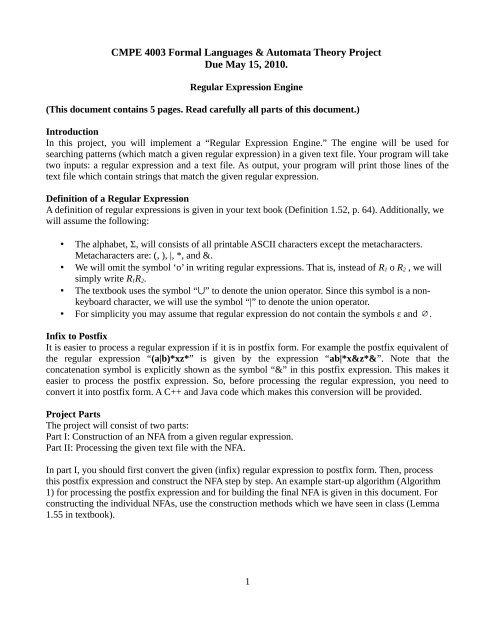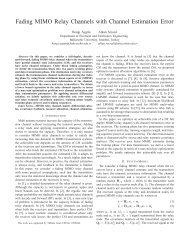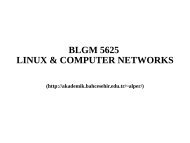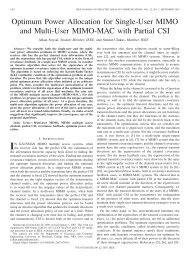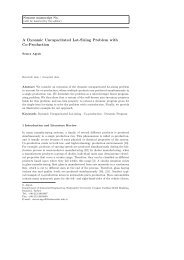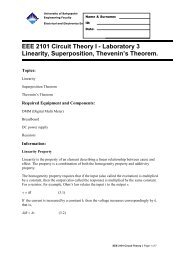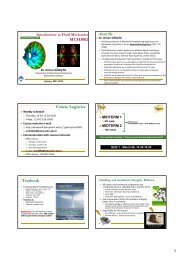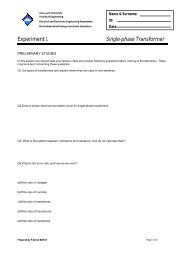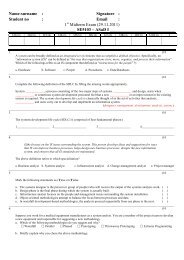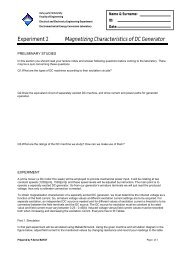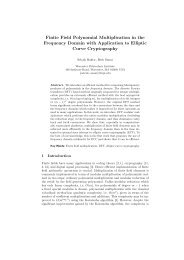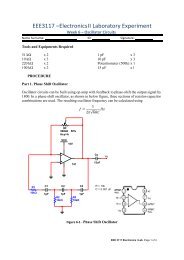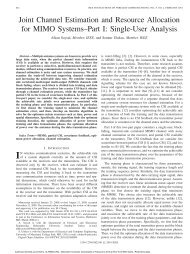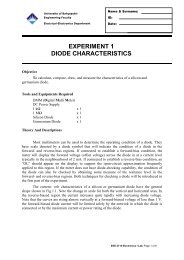Project Documentation - A web page that points a browser to a ...
Project Documentation - A web page that points a browser to a ...
Project Documentation - A web page that points a browser to a ...
Create successful ePaper yourself
Turn your PDF publications into a flip-book with our unique Google optimized e-Paper software.
CMPE 4003 Formal Languages & Au<strong>to</strong>mata Theory <strong>Project</strong><br />
Due May 15, 2010.<br />
Regular Expression Engine<br />
(This document contains 5 <strong>page</strong>s. Read carefully all parts of this document.)<br />
Introduction<br />
In this project, you will implement a “Regular Expression Engine.” The engine will be used for<br />
searching patterns (which match a given regular expression) in a given text file. Your program will take<br />
two inputs: a regular expression and a text file. As output, your program will print those lines of the<br />
text file which contain strings <strong>that</strong> match the given regular expression.<br />
Definition of a Regular Expression<br />
A definition of regular expressions is given in your text book (Definition 1.52, p. 64). Additionally, we<br />
will assume the following:<br />
• The alphabet, Σ, will consists of all printable ASCII characters except the metacharacters.<br />
Metacharacters are: (, ), |, *, and &.<br />
• We will omit the symbol ‘o’ in writing regular expressions. That is, instead of R 1 o R 2 , we will<br />
simply write R 1 R 2 .<br />
• The textbook uses the symbol “ ⋃ ” <strong>to</strong> denote the union opera<strong>to</strong>r. Since this symbol is a nonkeyboard<br />
character, we will use the symbol “|” <strong>to</strong> denote the union opera<strong>to</strong>r.<br />
• For simplicity you may assume <strong>that</strong> regular expression do not contain the symbols ε and ∅.<br />
Infix <strong>to</strong> Postfix<br />
It is easier <strong>to</strong> process a regular expression if it is in postfix form. For example the postfix equivalent of<br />
the regular expression “(a|b)*xz*” is given by the expression “ab|*x&z*&”. Note <strong>that</strong> the<br />
concatenation symbol is explicitly shown as the symbol “&” in this postfix expression. This makes it<br />
easier <strong>to</strong> process the postfix expression. So, before processing the regular expression, you need <strong>to</strong><br />
convert it in<strong>to</strong> postfix form. A C++ and Java code which makes this conversion will be provided.<br />
<strong>Project</strong> Parts<br />
The project will consist of two parts:<br />
Part I: Construction of an NFA from a given regular expression.<br />
Part II: Processing the given text file with the NFA.<br />
In part I, you should first convert the given (infix) regular expression <strong>to</strong> postfix form. Then, process<br />
this postfix expression and construct the NFA step by step. An example start-up algorithm (Algorithm<br />
1) for processing the postfix expression and for building the final NFA is given in this document. For<br />
constructing the individual NFAs, use the construction methods which we have seen in class (Lemma<br />
1.55 in textbook).<br />
1
After constructing the final NFA, you should process the given text file. Process the text file line by<br />
line. That is, begin with the first line of text and check whether the NFA accepts it or not. If it accepts<br />
then print <strong>that</strong> line, if it does not accept then print nothing. Proceed in this fashion until the end of the<br />
text. An example algorithm (Algorithm 2) for simulating the processing of an NFA for a given string is<br />
provided in this document.<br />
For the first part you are given a class design with the accompanying code in both C++ and Java, so it<br />
could be easier for you <strong>to</strong> start with it. It is up <strong>to</strong> you <strong>to</strong> decide whether <strong>to</strong> use <strong>that</strong> code or not, you may<br />
also use it partially. What is required is <strong>that</strong> your code should be able <strong>to</strong> build NFA <strong>that</strong> recognizes<br />
given regex after translating it <strong>to</strong> postfix form and then be able <strong>to</strong> process a file and output the<br />
matching lines as expected.<br />
Bonus (30 <strong>points</strong>): Write the code for converting the NFA in<strong>to</strong> a DFA (using the construction in<br />
Theorem 1.39). Give the user an option so <strong>that</strong> s/he can choose whether <strong>to</strong> process the text file with a<br />
DFA or an NFA. If the user chooses DFA then process the text file with the DFA. If the user chooses<br />
NFA then process the text file with the NFA. (Note <strong>that</strong> if the user opts for an NFA then you don’t need<br />
<strong>to</strong> construct the DFA). Compare the running times of both cases (DFA or NFA) and report your<br />
observations. How can you explain the difference in the running times<br />
<strong>Project</strong> Groups<br />
You can work in groups. There can be at most 2 people in a single group. You are responsible for<br />
forming your group until 22.04.11 and register yourself in the list maintained by the TA.<br />
Submission and Grading: (Please read very carefully!)<br />
1. You must provide source code in Java or C/C++ and make sure <strong>that</strong> your code can be compiled<br />
and run from Linux OS command line using javac or gcc/g++. If you use multiple languages,<br />
we will appreciate if your project can simply be compiled e.g. using makefile. Make a tarball<br />
and send it <strong>to</strong> cmpe4003@gmail.com before deadline.<br />
2. Comment and indent your code clearly.<br />
3. You must prepare a clear detailed report of your work including your “reasoning” (design and<br />
implementation details) and at least “5 test runs” on large files with regular expressions of<br />
different complexities. Present this report both as hardcopy and also soft copy in the tarball.<br />
4. You must do your own work. You may discuss high level ideas with classmates, but you must<br />
write them ALONE in an isolated environment! If you get help, you must acknowledge <strong>that</strong><br />
help in your writing. IT’S NOT ALLOWED TO USE SOMEBODY ELSE’s CODE PARTLY or<br />
FULLY – THIS MAY BE A FRIEND, WEB PAGE OR A BOOK. WE HAVE ZERO<br />
TOLERANCE WHEN IT COMES TO CHEATING, UNIVERSITY’S RULES and<br />
REGULATIONS APPLY.<br />
5. With appointment, we will ask you <strong>to</strong> present your work for 5-10 minutes. Questions will be<br />
asked <strong>to</strong> group members separately. If one of the group members cannot explain what they have<br />
done clearly, it is considered cheating. Therefore, do only what you can.<br />
2
Algorithm 1 for constructing an NFA from a given postfix regular expression:<br />
while (not end of postfix expression) {<br />
c = next character in postfix expression;<br />
if (c == ‘&’) {<br />
nfa2 = pop();<br />
nfa1 = pop();<br />
push(NFA <strong>that</strong> accepts the concatenation of L(nfa1) followed by L(nfa2));<br />
}<br />
else if (c == ‘|’) {<br />
nfa2 = pop();<br />
nfa1 = pop();<br />
push(NFA <strong>that</strong> accepts L(nfa1) ∪ L(nfa2));<br />
}<br />
else if (c == ‘*’) {<br />
nfa = pop();<br />
push(NFA <strong>that</strong> accepts L(nfa)*);<br />
}<br />
else {<br />
push(NFA <strong>that</strong> accepts a single character c);<br />
}<br />
}<br />
3
Algorithm 2 for simulating the processing of an NFA, M = (Q, Σ, δ, S, F), for a given input string.<br />
T = ∅; P = ∅;<br />
while (true) {<br />
P = P ∪ S;<br />
// compute the epsilon closure of P.<br />
do {<br />
T = P;<br />
for (each δ(q, ε) where q∈P )<br />
P = P ∪ δ( q, ε);<br />
} while (T ≠ P ); // loop again if P is modified<br />
if (T ∩ F ≠ ∅)<br />
break;<br />
// if it is the end of input string then break<br />
if (input empty)<br />
break;<br />
c = next character in the string<br />
// compute next state of the NFA<br />
T = ∅;<br />
for (each δ(q, c) where q∈P )<br />
T = T ∪ δ( q, c);<br />
if (T ∩ F ≠ ∅)<br />
break;<br />
P = T;<br />
}<br />
accept iff (T ∩ F ≠ ∅);<br />
4
Sample Test run<br />
USAGE: java Main ’(infix regexp)’ (file)<br />
$ java Main ’tam|(b*az)’ test.txt<br />
Regex in Postfix form:<br />
ta&m&b*a&z&|<br />
Following NFA was built:<br />
startState<br />
= 15<br />
acceptStates = [13, 16]<br />
allStates = [1, 2, 3, ...]<br />
edges:<br />
(5, 6, 'm')<br />
(12, 13, ε)<br />
(10, 11, ε)<br />
(9, 10, ε)<br />
(1, 2, 't')<br />
(11, 12, 'a')<br />
(7, 8, 'b')<br />
(8, 10, ε)<br />
...<br />
NFA simulation results :<br />
ACCEPTED LINE (0) : tamtamlar caliyor.<br />
ACCEPTED LINE (4) : tatatamam.<br />
ACCEPTED LINE (5) : mxazabbaaaabcaz<br />
ACCEPTED LINE (6) : iki cambaz bir ipte oynamaz<br />
NFA simulation <strong>to</strong>ok: 61.925702 ms<br />
5


